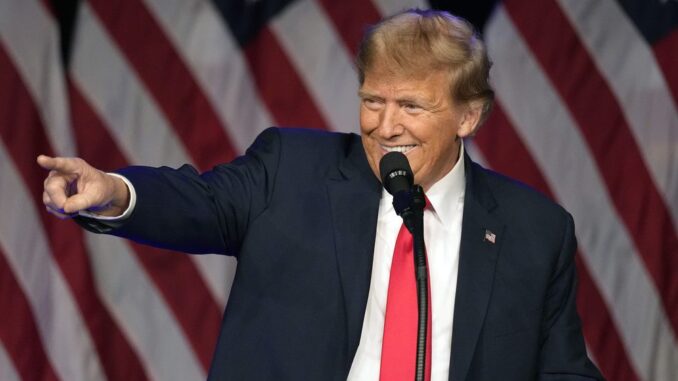
As I’ve watched some of President Donald Trump’s former appointees and allies say they can’t support him in 2024, I was reminded of a similar scenario in American history.
In 1936, former New York Gov. Al Smith decided that he could not support President Franklin Delano Roosevelt’s reelection.
Smith was a popular reform Democrat who had been elected governor of New York four times. In 1928, he became the first Catholic ever nominated for president by a major party. To strengthen his campaign, Smith convinced Roosevelt, who was then recovering from polio at Warm Springs, Georgia, to come back and run for governor. Smith lost the presidential race to Herbert Hoover, but Roosevelt became governor of New York.
When Roosevelt’s New Deal embraced government activism, powerful measures of intervening in the economy, and creating government programs for the poor and unemployed, Smith was alienated. He had been part of the eastern conservative wing of the Democratic Party, which had fought against William Jennings Bryan and his Western populism.
Smith was closer to the business establishment than to radical college professors.
Finally, Smith could no longer support the man he had previously recruited. On Jan. 26, 1936, Smith said at the American Liberty League Dinner:
“I must make a confession. It is not easy for me to stand up here tonight and talk to the American people against the Democratic administration. This is not easy. It hurts me. But I can call upon innumerable witnesses to testify to the fact that during my whole public life I put patriotism above partisanship. And when I see danger — I say ‘danger,’ that is, the ‘Stop, look and listen’ to the fundamental principles upon which this government of ours was organized — it is difficult for me to refrain from speaking up.”
Despite Smith’s defection, the Roosevelt New Deal coalition was massive (Roosevelt defeated Republican Kansas Gov. Alf Landon by 523 electoral votes and received 60.8% of the vote). Landon carried only Maine and Vermont.
I tell that story to say this: The anti-Trump Republicans resemble the anti-Roosevelt Democrats of 1936. They yearn for a party which has disappeared. They advocate policies which are no longer realistic or viable. They are repelled by Trump’s aggressive style and his dramatic shifts in policy.
They are rapidly becoming a fossilized reminder of a party which no longer exists — and wants to operate in a world which no longer exists.
Some have begun to harken back to the President Ronald Reagan years as a golden time. They wish the GOP could return to them. It is impossible to return to the 1980s because the world has changed. The problems have changed. The politics have changed. And the institutions are sicker and more destructive than they were under Reagan.
I first spent time with then-Gov. Reagan in 1974. I worked to create the first Capitol Steps event for candidate Reagan in 1980. For eight years, I served in the House as an active ally of President Reagan on nearly every issue. Reagan was bold in his visionary approach but careful and cautious in taking risks. While he said the ultimate outcome of the Cold War would be “we win, they lose,” he did not risk military confrontation with the Soviet Union.
Reagan would have been appalled at a 22-year war in Afghanistan, which the former chairman of the Joint Chiefs admitted this week was a strategic defeat.
Reagan warned in his farewell address that we were losing ground to a cultural effort to undermine our history, destroy the spirit of patriotism and eliminate learning what it meant to be an American. He would be much bolder and more radical today — faced with collapsing inner-city schools and radical anti-Americanism on college campuses. The Gov. Reagan who took on the counterculture at Berkeley was a much tougher and more intense opponent than the Morning in America Reagan from the 1984 campaign.
People who object to Trump’s aggressiveness and hide behind a sanitized, phony memory of Reagan forget that it was Gov. Reagan who said of the Berkeley protests, “If it takes a bloodbath, let’s get it over with, no more appeasement.”
As Matthew Continetti recently wrote for National Review, “If Donald Trump is elected president in November, he will have assembled a coalition unlike any Republican nominee in my lifetime.”
Citing research from the American Enterprise Institute, Continetti pointed out that Trump’s favorability is growing. His popularity is now at its highest point since he left office, and he is making steady gains with white and black Americans — and big gains with Hispanic Americans.
Continetti captured the current challenge for the anti-Trump Republicans: “We aren’t used to a politics where the party of the ‘Left’ represents the establishment, and the party of the ‘Right’ represents an insurgent movement against the settled way of doing things.”
In short, traditional Republicans who wanted to be part of the establishment are being alienated by new Republicans who want to change that establishment.
The traditional Republican leadership (largely the Bush wing of the party) came from Yale, Harvard, and Princeton, and had similar pedigrees. They see themselves as governing within the right wing of the old order. They are naturally repelled by the boisterous, noisy emergence of a working-class Republican movement which includes Latinos, African Americans, and blue-collar whites. It doesn’t help that the new Republicans want to shatter the old order — not join it.
Think of the anti-Trump Republicans as the Al Smith branch of the GOP. Their complaints will tell you more about them than Trump — and they will also lose.



